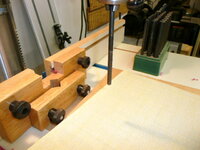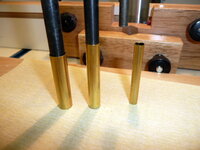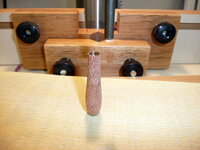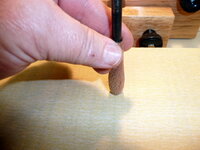MyronW
Member
I love cool jigs and fixtures, but my shop is full and my bank account isn't and I needed a dead-on accurate way to square the ends of blanks after turning and finishing. This is what works for me.
The basic setup is simply the drill press, a set of transfer punches, a small piece of smooth plywood (mine is a 12" square of baltic birch), and assorted sandpaper. I don't glue the sandpaper down, because I shift it around a lot as I work. Clean sandpaper cuts much faster.
Find the right size punch for the tube you are using, and chuck it with the point up. This will keep the plywood from getting wrecked. Adjust the drill press so that there is enough gap to get the workpieces in and out, and for the punch to make firm contact with the sandpaper.
Please note that this is strictly a non-powered operation. The drill press is just a guide.
Place the workpiece on the punch, lower it down to the sandpaper, and twirl it back and forth a couple of times. That's usually all it takes.
Norton 3X 220 cuts fast and clean, but delicate woods require finer grits. If you're trying to do unturned blanks, get some 100 grit and pack a lunch. It will take a while!
The basic setup is simply the drill press, a set of transfer punches, a small piece of smooth plywood (mine is a 12" square of baltic birch), and assorted sandpaper. I don't glue the sandpaper down, because I shift it around a lot as I work. Clean sandpaper cuts much faster.
Find the right size punch for the tube you are using, and chuck it with the point up. This will keep the plywood from getting wrecked. Adjust the drill press so that there is enough gap to get the workpieces in and out, and for the punch to make firm contact with the sandpaper.
Please note that this is strictly a non-powered operation. The drill press is just a guide.
Place the workpiece on the punch, lower it down to the sandpaper, and twirl it back and forth a couple of times. That's usually all it takes.
Norton 3X 220 cuts fast and clean, but delicate woods require finer grits. If you're trying to do unturned blanks, get some 100 grit and pack a lunch. It will take a while!




